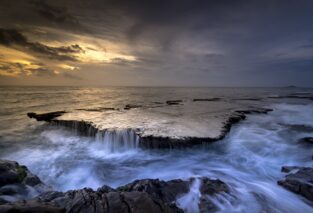If you’re new to the world of shore fishing, you might be feeling a mix of excitement and uncertainty. But fear not, because we’ve got you covered with our Essential Tips for Shore Fishing Newcomers. Whether you’re planning a relaxing day by the water or looking for the thrill of catching your own dinner, these tips will help you navigate the ins and outs of shore fishing, from choosing the right location to mastering the art of casting. So grab your fishing gear and get ready to embark on an unforgettable fishing adventure!

Choosing the Right Location
When it comes to shore fishing, choosing the right location is key to maximizing your chances of success. The first thing to consider is the type of fish you want to catch. Different fish species have different preferences when it comes to habitat and feeding grounds. For example, if you’re targeting bass, you’ll want to look for areas with plenty of submerged vegetation or rocky structures where they like to hide. On the other hand, if you’re going after trout, you’ll want to focus on streams and rivers with plenty of oxygenated water.
Researching local fishing spots is another important step in choosing the right location. The Internet can be a great resource for finding information on popular fishing spots in your area. Look for fishing forums or websites where anglers share their experiences and tips. Local fishing shops and bait shops can also provide valuable insights into where the fish are biting.
One crucial factor to consider when selecting a fishing spot is the presence of structure or cover. Fish love areas where they can hide and find protection from predators. Look for spots with fallen trees, submerged rocks, or grassy areas. These features provide shelter for fish and can significantly increase your chances of catching them.
Understanding Tide and Current
Tides and currents play a significant role in fish movement and behavior. Learning how they affect fishing can greatly enhance your chances of success. Tides refer to the rise and fall of the ocean level, caused by the gravitational pull of the moon and the sun. As the tide changes, it stirs up food sources and causes fish to become more active.
When planning your fishing trip, pay attention to the tides. Fishing during incoming or outgoing tides can be a good strategy, as the movement of water often triggers feeding activity. Fish use the changing tides to their advantage, positioning themselves in specific areas to take advantage of the incoming prey.
However, it’s essential to be aware of rip currents and how they impact fishing. Rip currents are powerful, narrow channels of fast-moving water that flow away from the shore. They can create dangerous conditions for both swimmers and fishermen. It’s crucial to familiarize yourself with the signs of rip currents and avoid fishing in areas where they are present.
Selecting the Appropriate Bait and Lures
Choosing the right bait and lures is crucial for attracting fish and getting them to bite. Live bait is often the preferred choice for shore fishing because it presents a natural and enticing meal for the fish. Worms, minnows, and shrimp are all popular live bait options that can be easily found at most bait shops. Remember to use a hook that matches the size of your bait to ensure a proper presentation.
Artificial lures, on the other hand, offer more versatility and can be a great option if live bait is not readily available or if you want to try something different. There is a wide variety of artificial lures on the market, including plugs, spoons, and soft plastics. Experiment with different colors, sizes, and types of lures to determine what works best for the fish species you are targeting.
Matching the bait to the type of fish you are targeting is essential. Different fish have different feeding preferences, and using the right bait can make all the difference. Do some research on the specific fish species you are targeting and find out what they typically feed on. This will help you select the appropriate bait or lure that closely resembles their natural prey.
Mastering Casting Techniques
To be successful in shore fishing, it’s important to learn and master casting techniques. Casting with accuracy and distance will allow you to reach the fish in their feeding territory and increase your chances of getting a bite. Practice makes perfect, so take the time to work on your casting skills.
There are different casting techniques you can experiment with, such as overhead casting, sidearm casting, and roll casting. Each technique has its advantages and is suitable for different fishing situations. By mastering multiple casting techniques, you’ll be better prepared to adapt to different fishing conditions.
The type of rod and reel combo you use can also affect your casting distance and accuracy. Consider experimenting with different combinations to find what works best for you. A longer rod can provide greater casting distance, while a shorter rod may offer better accuracy in tight spaces. Don’t be afraid to try different setups until you find the one that feels comfortable and suits your style of fishing.

Understanding Fish Behavior and Feeding Patterns
Observing fish behavior and understanding their feeding patterns is crucial for successful shore fishing. Spend some time observing the water for signs of fish activity. Look for jumping fish, diving birds, or ripples on the surface, as these are indications that fish are present in the area.
Different fish species have different feeding habits, and knowing their preferences can give you an edge. Some fish are bottom feeders, while others prefer to stay near the surface. Research each fish species you are targeting and learn about their feeding behaviors. Understanding the natural movements of their prey can help you mimic those movements with your bait or lures, making it more enticing for the fish to bite.
Being Patient and Persistent
Fishing can be unpredictable, and it’s important to stay patient and persistent. Some days the fish may not be biting as much as you’d like, but that doesn’t mean they’re not there. Don’t get discouraged and keep trying different techniques and locations. Sometimes it just takes a little bit of time and persistence to find the right spot or trigger the fish to start feeding.
When shore fishing, it can be beneficial to stay in one spot for an extended period. As you remain in the same location, you become familiar with the fishing conditions and can adjust your strategy accordingly. Patience is often rewarded in fishing, so give each spot a fair chance before moving on.
Keep experimenting with different techniques and locations to see what works best for you. Don’t be afraid to try new things and step out of your comfort zone. The more you learn and adapt, the better angler you will become.

Adapting to Weather Conditions
Weather conditions play a significant role in fish behavior, and it’s important to adapt your fishing technique based on the weather. Consider how different weather factors, such as wind, temperature, and precipitation, can impact fish activity.
For example, on a hot summer day, fish may be more active in the early morning or late evening when the temperatures are cooler. Windy conditions can make it challenging to cast and control your bait or lures, so it’s necessary to adjust your casting technique and choose areas that offer some shelter from the wind. Rain can also affect fish behavior, as it can wash insects and other food sources into the water, triggering feeding activity.
Pay attention to the weather forecast before heading out for a fishing trip. This will give you an idea of what to expect and help you plan accordingly. Remember to dress appropriately and bring any necessary gear to ensure your safety and comfort in different weather conditions.
Using the Right Fishing Equipment
Having the right fishing equipment is essential for a successful shore fishing experience. Invest in a quality fishing rod and reel that is suitable for the type of fishing you will be doing. Consider the weight and action of the rod, as well as the line capacity of the reel. A well-balanced setup will help you cast farther and have better control over your line.
Choose the appropriate fishing line and tackle for the fish species you are targeting. Monofilament lines are versatile and suitable for a wide range of fishing conditions. However, if you’re targeting larger fish or fishing in areas with heavy cover, you may want to consider using a braided fishing line for added strength and durability.
Bringing essential accessories like pliers, scissors, and sunscreen is also important. Pliers will come in handy for removing hooks, while scissors are useful for cutting line or adjusting bait. Don’t forget to apply sunscreen to protect your skin from the sun’s harmful rays, especially if you’ll be spending a significant amount of time fishing in the open.

Learning Local Regulations and Fishing Etiquette
Before you start shore fishing, it’s important to research and follow local fishing regulations. Each area may have specific rules and regulations regarding bag limits, size restrictions, fishing seasons, and fishing methods. Ignoring these regulations can result in fines or penalties, and it’s our responsibility as anglers to protect and conserve fish populations.
Respecting other anglers and their fishing space is also crucial. Avoid crowding other fishermen and give them plenty of space to fish comfortably. If you’re fishing in a popular area, be mindful of your noise level and avoid disturbing the tranquility of the surroundings. Fishing should be an enjoyable experience for everyone, and practicing good fishing etiquette ensures a positive atmosphere for all anglers.
Consider practicing catch and release to conserve fish populations for future generations. If the fish you catch is within legal limits, take a quick photo or simply admire its beauty and release it back into the water. This helps to maintain healthy fish populations and allows the fish to grow and reproduce.
Staying Safe While Shore Fishing
Safety should always be a top priority when engaging in any outdoor activity, and shore fishing is no exception. Here are some tips to stay safe while enjoying your fishing adventure:
- Wear appropriate clothing and footwear to protect yourself from the elements. Dress in layers, as weather conditions can change rapidly. Consider wearing a hat and sunglasses to protect yourself from the sun and bring rain gear if there’s a chance of precipitation.
- Watch out for slippery surfaces near the water. Rocks, docks, and vegetation can be slippery, especially when wet. Take your time and use caution when moving around to avoid accidents or falls.
- Be cautious of strong waves or undertows. If you’re fishing along the shoreline, be aware of your surroundings and stay away from areas with strong currents. If the waves are crashing against the shore, it’s a good indication that the water conditions may not be suitable for fishing.
By following these safety tips, you can ensure a pleasant and safe shore fishing experience.
In conclusion, shore fishing offers a fantastic opportunity to connect with nature and enjoy the thrill of catching fish. By choosing the right location, understanding tide and current, selecting the appropriate bait and lures, mastering casting techniques, understanding fish behavior and feeding patterns, being patient and persistent, adapting to weather conditions, using the right fishing equipment, learning local regulations and fishing etiquette, and staying safe, you can increase your chances of success and create lasting memories on your shore fishing adventures. Happy fishing!






